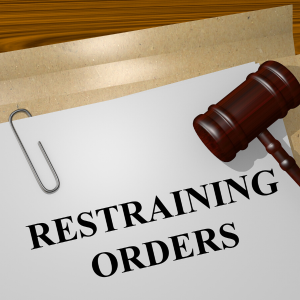 A restraining order in Texas is a powerful legal tool designed to protect victims of domestic violence from future harm or harassment. However, once a restraining order is granted, both the person seeking protection and the person against whom the order is issued may have questions about what happens next. One common concern is how the individual subject to the restraining order is notified. Understanding the notification process is important for ensuring the restraining order is enforced properly. To help both sides of the restraining order process, we’ll explain how the restraining order notification process works in Texas, including how the person the order is against is officially informed. We also provide more information on how to get a restraining order in Texas on our website. Whether you’re seeking protection from an abuser or navigating the legal restraints placed on you, it’s important to know what to expect during this process.
A restraining order in Texas is a powerful legal tool designed to protect victims of domestic violence from future harm or harassment. However, once a restraining order is granted, both the person seeking protection and the person against whom the order is issued may have questions about what happens next. One common concern is how the individual subject to the restraining order is notified. Understanding the notification process is important for ensuring the restraining order is enforced properly. To help both sides of the restraining order process, we’ll explain how the restraining order notification process works in Texas, including how the person the order is against is officially informed. We also provide more information on how to get a restraining order in Texas on our website. Whether you’re seeking protection from an abuser or navigating the legal restraints placed on you, it’s important to know what to expect during this process.
- Can You Be Notified Over The Phone?
- In Person Notification
- Who Can Serve A Restraining Order In Texas?
- What If The Person Can’t Be Found?
- Legal Notification of a Restraining Order
Can You Be Notified Of A Restraining Order Over The Phone?
It’s important to know that you cannot be officially notified of a restraining order against you over the phone. If someone calls and informs you that a restraining order in Texas has been issued against you, this is not the same as being formally notified or served. Official notification, also known as “service of process,” is a legal procedure that makes sure you are properly made aware of the order and the restrictions it imposes on you. This process must be carried out according to Texas law to ensure your rights are protected and that the restraining order is enforceable. Simply receiving a phone call or being told by someone else does not fulfill the legal requirements for notification of a restraining order. To ensure you are fully informed of the restraining order and understand your legal obligations, you must be officially served through the proper channels.
In Person Notification
Does a restraining order have to be served in person? Yes, the only legal notification for a restraining order in Texas is when the person the order is against is served in person. This means that the individual that order is against must be personally served with a copy of:
- Your petition
- Any temporary restraining order (if applicable)
- Notice of the hearing where the judge will decide whether to grant an official protective order or not
This in-person notification service must occur at least five days before the official hearing, unless the judge determines there is a valid reason to shorten this timeframe. The person being served can be notified by someone over the age of 18 who is not involved in the case. This could include a friend, relative, law enforcement officer, or a professional process server. It’s important to note that simply being told about the restraining order, whether over the phone or by someone else, does not meet the legal requirements for notification. The law requires formal, in-person service to ensure that the person is fully aware of the order and any related court proceedings.
Who Can Serve A Restraining Order In Texas?
The defendant must be personally served with a restraining order in Texas, and this can be done by a constable (law enforcement officer) or a private process server. A constable is a law enforcement officer who is authorized to deliver legal documents such as restraining orders. Alternatively, a private process server, who is professionally trained in serving legal documents, can also carry out the service. Both options make sure that the defendant is officially notified of the restraining order and any associated court hearings, fulfilling the legal requirements for proper notification. It’s important to remember that the person serving the restraining order must be over the age of 18 and cannot be directly involved in the case.
What If The Person Can’t Be Found To Serve Them The Restraining Order?
If the person that whom the restraining order has been placed against cannot be located for personal notification service, there are still options available to ensure the order is enforced. In Texas, a restraining order is valid once issued, but it generally cannot be enforced until the respondent has been properly notified and served. If the respondent cannot be found for in-person service, and you are unable to serve the restraining order, the victim may choose to keep a copy of the restraining order on them at all times and contact the police or a third party to help serve the order if the respondent comes near them. However, this is not always beneficial, especially for those who are trying to avoid their abuser.
One alternative is service by registered or certified mail, with a return receipt requested. The court clerk or constable will mail the order and associated court papers to the respondent. If the respondent signs the return receipt, the clerk will complete a Return of Service form, which confirms when and where the respondent was served the restraining order. However, this option only works if the victim is confident that the respondent will sign the letter. If someone else signs or the respondent does not sign their name exactly as it appears on the petition, you will need to pay another fee and attempt service through a different method.
What happens if a restraining order is not served? If service by certified mail or personal service is unsuccessful, victims may be able to request the judge’s permission to serve the respondent in another way. This can be done by filing a Motion for Substituted Service and a Rule 106(b) Affidavit, which confirms that attempts to serve the respondent were made at a known location where they live or work. If the Texas judge is satisfied with this information, they may sign an Order for Substituted Service, allowing the constable, sheriff, or private process server to leave a copy of the papers:
- With someone over the age of 16 at the location
- Authorize another effective method of service
What Is Legal Notification of a Restraining Order in Texas?
In Texas, official notification of a restraining order, known as “service of process,” must be done in person. The individual the order is against cannot be legally notified over the phone. They must be personally served with a copy of the petition, any temporary restraining order, and notice of the hearing at least five days before the court date. Service can be conducted by a law enforcement officer (constable) or a private process server who is over 18 and not involved in the case.
If the person cannot be located, alternatives include service by certified mail (requiring the respondent’s signature) or filing a Motion for Substituted Service, where the court may authorize alternative methods, such as leaving the documents with someone over 16 at a known location. These measures ensure the respondent is formally and legally notified to make the restraining order enforceable.



